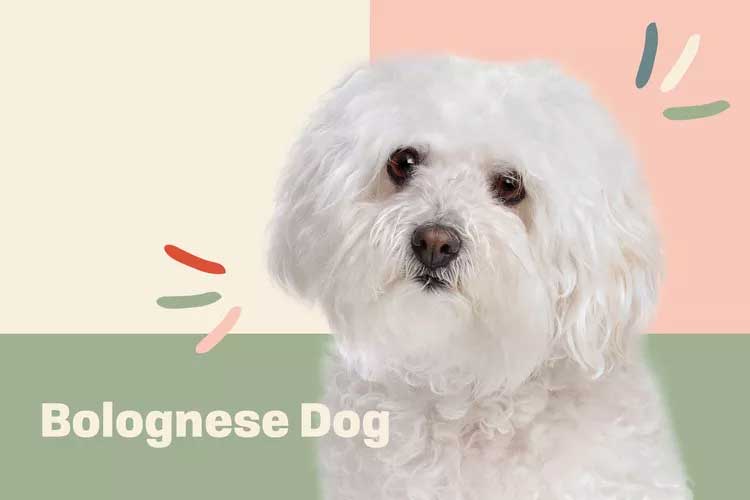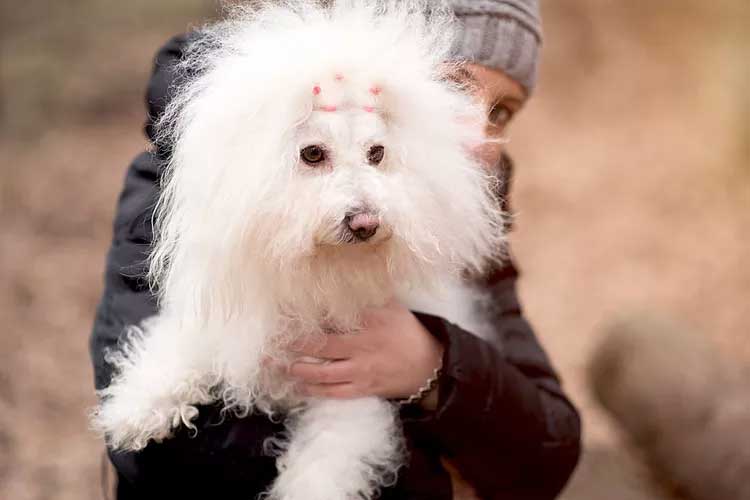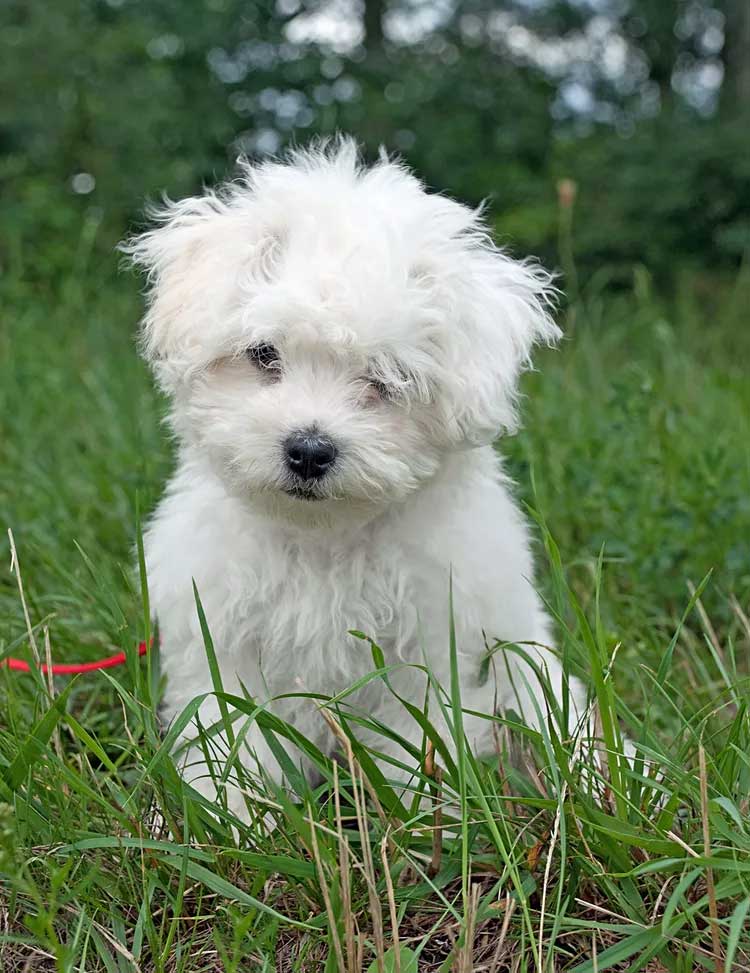Bolognese dogs are good-natured pups that don’t shed much and are great with kids and other pets. Learn more about what makes this rare, easygoing breed so lovable.

Bolognese Overview
| OFFICIAL NAME | Bolognese |
| COMMON NAME | Bolognese |
| PET HEIGHT | 10 to 12 inches |
| PET WEIGHT | 5 to 9 pounds |
| LIFESPAN | 12 to 14 years |
| GOOD WITH | cats, children, dogs, families, seniors |
| TEMPERAMENT | friendly, playful, willful |
| INTELLIGENCE | high |
| SHEDDING AMOUNT | infrequent |
| EXERCISE NEEDS | medium |
| ENERGY LEVEL | calm |
| VOCAL LEVEL | when necessary |
| DROOL AMOUNT | low |
| BREED GROUP | none |
| BREED SIZE | small (0-25 lbs.) |
| COAT LENGTH | long |
| COLORS | white |
| OTHER TRAITS | apartment-friendly, hypoallergenic, low prey drive |
Bolognese dogs were status symbols during the Renaissance, gifted between European nobility. These fluffy white dogs were adored for their beauty and loyalty—so much so that the likeness of the Italian Bolognese appears in art from the era. Now, centuries later, Bolognese dogs, also known as "Bolos," remain a beloved (albeit rare) breed that can thrive in just about any home, as long as she has ample time with her humans.
"Bred as a companion dog, the Bolognese is affectionate, people-oriented, and good-natured," says Jen Jones, a professional dog trainer and behavior specialist who runs Your Dog Advisor. "This dog does well with families and other pets, though she can suffer from separation anxiety if left alone too long. For this reason, she is best suited for families and owners with flexible schedules."
Appearance
With soft, slightly tufted coats, Bolognese dogs feel—and look—like fluffy cotton balls when they cuddle up on your lap (which, by the way, is one of their favorite places to be!). While no dog is entirely hypoallergenic, Bolos do tend to wear long and wavy coats that don't shed much, which can make these dogs ideal pets for mild allergy sufferers.
Their unshaped coats are white or ivory. According to the American Bolognese Club (ABC), many families keep their pets in a shorter coat and leave an untrimmed "mop head" (much like Einstein's unruly hair!). But more regular grooming is needed if the Bolognese wears a full coat, according to the club.
Bolognese are small dogs with stocky, square bodies that weigh between 5.5–9 pounds and are 10–12 inches tall. They're occasionally confused for the Maltese; the dogs are near doppelgängers because of their similar small stature, flowing white locks, and gentle demeanor. Bolos, though, are slightly larger than their Maltese cousins, and their unshaped coats can give them a tad of an eccentric look.
Other characteristics that define the noble Bolognese dogs include round, black eyes; a black gumdrop nose; black nails; and a feathered tail that curls up over their backs.
Temperament
Bolognese dogs tend to be quite calm, according to the ABC. They are playful, easygoing, and earnest."The Bolognese is a lovebug and a family dog that enjoys spending time with his or her family," says Nicole Ellis, CPDT-KA, pet lifestyle expert with Rover. "They're a very intelligent small breed that loves to learn and can also calm down to cuddle."
While Bolos are loyal to their families, according to the ABC, they can also be somewhat reserved and shy. But with early socialization, a Bolognese puppy will grow to warm up to strangers.

An affable breed, the Bolognese gets along well with most other household pets as well as children. But, as with all breeds, kids and Bolos should be supervised while playing—these small-boned dogs can't withstand an enthusiastic child's bear hugs or rough-housing.
Living Needs
Bolognese dogs were bred for companionship and are happiest when they're with their humans, whether it's trotting around the block together or cuddling up on the couch. The Bolognese dog breed is one that's best suited for retirees or a household where at least one pet parent works from home.To put it another way? Your Bolo doesn't like to fly solo.
"Bolognese are calm but faithful with a playful and easygoing side," says Michelle Burch, DVM at Safe Hounds Pet Insurance. "These dogs love people, resulting in separation anxiety if left alone for long periods."
Signs of separation anxiety can include behaviors such as nonstop barking and howling, chewing up your rugs, intense pacing, or having accidents and going potty in the house. So make sure you give your Bolognese the pats, cuddles, and quality time she deserves!
As a generally calm breed, Bolos can fare just fine in an apartment, so long as they have moderate exercise plans, according to the ABC.
Care
Their fur may look effortless and a tad wild, but all that fluff is difficult to maintain! Bolognese dogs—known for their soft, all-white coats—will need occasional baths to keep their pristine white fur looking sharp. These dogs have wavy, long coats that need to be brushed at least a few times a week. If you keep your Bolognese in her full coat (instead of a 1-inch short coat), you'll need more frequent trips to the groomer. But no matter the style of coat she dons, a Bolognese needs to have the hair around her eyes regularly trimmed.In addition to maintaining your Bolo's all-white coat, other care routines to keep her in tip-top shape include daily teeth brushing, regular nail trimmings, frequent ear cleanings, and high-quality dog food.
Because Bolos love their people so much, they'll enjoy training with positive reinforcement as a way to bond with their humans. One thing to remember: These dogs are highly intelligent and willful, so they're pretty darn good at figuring out how to get what they want from their humans, Ellis says.
"Training from an early age can help you both set off on the right paw," she says.

As far as exercise goes, Bolognese dogs aren't endurance athletes. But they will enjoy a short walk on a daily or twice-a-day basis, according to the Bolognese Dog Club UK. Walks don't need to be too long in duration—about 30 minutes of exercise a day will do, plus some playtime, too.
Health
In general, Bolognese dogs are a healthy breed with lifespans of 12–14 years.Luxating patellas is a health condition these dogs may be prone to, according to the ABC. This condition occurs when your dog's kneecap dislocates and moves out of its typical position. Oftentimes, dogs with this condition will change how they walk, hopping on a leg or stretching out their leg trying to adjust the kneecap. Luxating patellas are a congenital condition, which means your dog is born with the health issue and it tends to be more common among toy breeds. In serious cases, surgery may be needed to give the kneecap more stability.
Bolognese dogs remain a somewhat rare breed in the United States, so prospective pet owners should be extra cautious when it comes to finding a reputable breeder who has a track record of producing healthy Bolognese puppy litters.
History
While Bolognese dogs are a rare breed, these enchanting pups originated in Bologna, Italy, and have been around for more than 2,000 years, according to the ABC.During the Renaissance, Italian nobility gifted Bolognese puppies to each other, and these small dogs were considered a symbol of wealth. Their adoring fans included Spanish King Phillip II and Empress of Russia Catherine the Great.
Despite the adoration for the breed, the Bolognese almost went extinct as European aristocracies declined. But, according to the ABC, a small group of breed enthusiasts saved the dogs from dying out and the Bolognese was accepted into the American Kennel Club's Foundation Stock Service in 1999.
Fun Facts
The Bolognese is considered part of the barbichon family of dogs that originated from small white dogs in Mediterranean countries. This makes the Bolognese, according to the ABC, a cousin to the Maltese, Havanese, and bichon frise.Queen Maria Theresa of Austria hired a taxidermist to preserve her beloved Bolognese, according to the ABC, and the dog can be seen at the National Museum of History in Vienna.
Bolognese dogs are depicted in Renaissance art and even mentioned by Aristotle in his writings, according to the ABC.